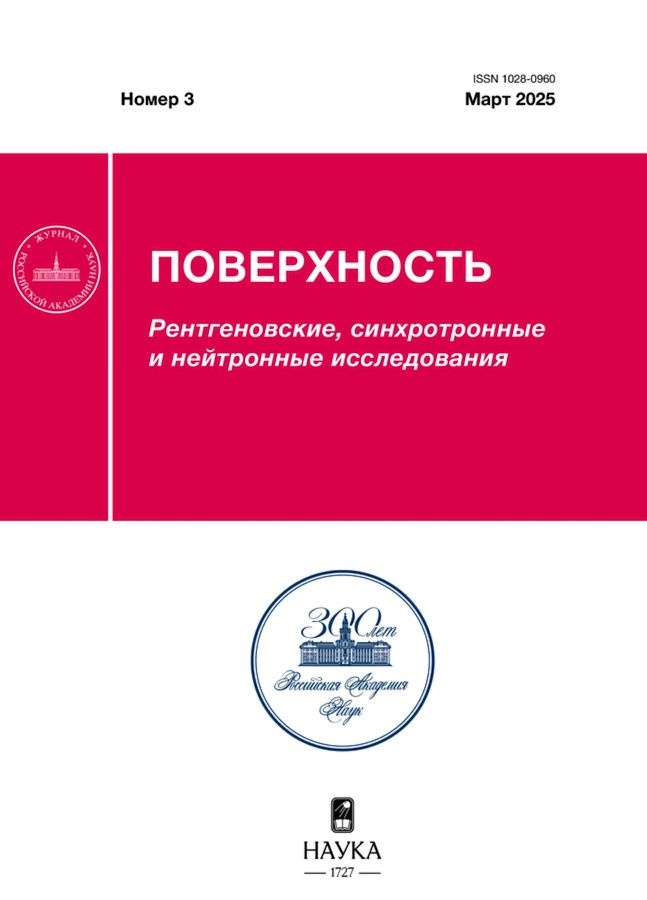Calculation of binding energy in a fragment of a teflon molecule using density functional theory
- 作者: Moskalenko S.S.1, Melkozerova Y.A.1, Gainullin I.K.1
-
隶属关系:
- Lomonosov Moscow State University
- 期: 编号 3 (2025)
- 页面: 75-79
- 栏目: Articles
- URL: https://archivog.com/1028-0960/article/view/687683
- DOI: https://doi.org/10.31857/S1028096025030126
- EDN: https://elibrary.ru/EMJSRP
- ID: 687683
如何引用文章
详细
To explain the increased yield of positive particles from the surface of a positively charged dielectric, a computer simulation was performed using the density functional theory. The model system was a fragment of a Teflon molecule (CF2) in a vacuum. The binding energy of atoms in this system in the neutral state (without removing electrons from the system) was calculated, after which a similar calculation was performed for an ionized fragment of the Teflon molecule (with the removal of one electron from the system of atoms). The calculations showed that the energy of complete dissociation of one fragment of the Teflon molecule in the neutral state is 11.02 eV, which agrees with the experimental data with good accuracy. The binding energy in the ionized fragment of the molecule is 2.86 eV, while the Teflon molecule fragment dissociates into a neutrally charged fluorine atom and a positively charged CF fragment. In calculations taking into account the dipole moment of the Teflon molecule fragment, the binding energy value was equal to — 2.75 eV, the Teflon molecule fragment also dissociated into a neutral fluorine atom and a positively charged CF fragment. The obtained results may be the reason for the increased release of positive particles from the surface of a positively charged massive dielectric.
全文:
作者简介
S. Moskalenko
Lomonosov Moscow State University
编辑信件的主要联系方式.
Email: ivan.gainullin@physics.msu.ru
俄罗斯联邦, Moscow
Yu. Melkozerova
Lomonosov Moscow State University
Email: ivan.gainullin@physics.msu.ru
俄罗斯联邦, Moscow
I. Gainullin
Lomonosov Moscow State University
Email: ivan.gainullin@physics.msu.ru
俄罗斯联邦, Moscow
参考
- Helium Ion Microscopy. / Ed. Hlawacek G., Golzahauser A. Springer International Publishing, 2016. P. 526. https://www.doi.org/10.1007/978-3-319-41990-9
- Petrov Yu.V., Anikeva A.E., Vyvenko O.F. // Nucl. Instrum. Methods Phys. Res. B. 2018. V. 425. P. 11. https://www.doi.org/10.1016/j. nimb.2018.04.001
- Ohya K., Yamanaka T., Takami D., Inai K. // Proc. SPIE. 2010. V. 7729. P. 146. https://www.doi.org/10.1117/12.853488
- Rau E.I., Evstafeva E.N., Andrianov M.A. // Phys. Solid State. 2008. V. 50. P 621. https://www.doi.org/10.1134/S1063783408040057
- Fakhfakh S., Jbara O., Belhaj M., Fakhfakh Z., Kallel A., Rau E.I. // Europ. Phys. J. Appl. Phys. 2003. V. 21. № 2. P. 137. https://www.doi.org/10.1051/epjap:2003001
- Baragiola R.A., Shi M., Vidal R., Dukes C. // Phys. Rev. B. 1998. V. 58. № 19. P. 13212. https://www.doi.org/10.1103/PhysRevB.58.13212.
- Shi J., Fama M., Teolis B., Baragiola R.A. // Nucl. Instrum. Methods Phys. Res. B. 2010. V. 268. № 19. P. 2888. https://www.doi.org/10.1016/j.nimb.2010.04.013
- Yogev S., Levin J., Molotskii M., Schwarzman A., Avayu O., Rosenwaks Y. // J. Appl. Phys. 2008. V. 103. Iss. 6. P. 064107. https://www.doi.org/10.1063/1.2895194
- Nagatomi T., Kuwayama T., Takai Y., Yoshino K., Morita Y., Kitayama M., Nishitani M. // Appl. Phys. Lett. 2008. V. 92. Iss. 8. P. 084104. https://www.doi.org/10.1063/1.2888957
- Nagatomi T., Kuwayama T., Yoshino K., Takai Y., Morita Y., Nishitani M., Kitagawa M. // J. Appl. Phys. 2009. V. 106. Iss. 10. P. 104912. https://www.doi.org/10.1063/1.3259428
- Ohya K. // J. Vacuum Sci. Technol. B. 2014. V. 32. Iss. 6. P. 06FC01. https://www.doi.org/10.1116/1.4896337
- Minnebaev K.F., Rau E.I., Tatarintsev A.A. // Phys. Solid State. 2019. V. 61. P. 1013. https://www.doi.org/10.1134/S1063783419060118
- Rau E.I., Tatarintsev A.A., Zykova E.Yu. Markovets (Ozerova) K.E., Minnebaev K.F. // Vacuum. 2020. V. 177. P. 109373. https://www.doi.org/10.1016/j.vacuum.2020.109373
- Зыкова Е.Ю., Иешкин А.Е., Миннебаев К.Ф., Озерова К.Е., Орликовская Н.Г., Рау Э.И., Татаринцев А.А. // Вестник Московского университета. Серия 3. Физика. Астрономия. 2023. № 2. https://www.doi.org/10.55959/MSU0579-9392.78.2320302
- Kohn W., Sham L.J. // Phys. Rev. 1965. V. 140. № 4A. P. A1133. https://www.doi.org/10.1103/PhysRev.140.A1133
- Gainullin I.K. // Phys. Rev. A. 2017. V. 95. № 5. P. 052705. https://www.doi.org/10.1103/PhysRevA.95.052705
- Gainullin I.K. // Computer Phys. Comm. 2017. V. 210. P. 72. https://www.doi.org/10.1016/j.cpc.2016.09.021
- Goldberg A., Yarovsky I. // Phys. Rev. B. 2007. V. 75. № 19. P. 195403. https://www.doi.org/10.1103/PhysRevB.75.195403
- Lininger C.N., Gauthier J.A., Li W.-L., Rossomme E., Welborn V.V., Lin Z., Head-Gordon T., Head-Gordon M., Bell A.T. // Phys. Chem. Chem. Phys. 2021. V. 23. № 15. P. 9394. https://www.doi.org/10.1039/D0CP03821K
- Ciufo R.A., Han S., Floto M.E., Eichler J.E., Henkelman G., Mullins C.B. // Phys. Chem. Chem. Phys. 2020. V. 22. № 27. P. 15281. https://www.doi.org/10.1039/D0CP02410D
- Liao X., Lu R., Xia L., Wang Z., Zhao Y. // Energy Environmental Mater. 2022. V. five. № 1. P. 157. https://www.doi.org/10.1002/eem2.12204
- Løvvik O.M. // Surf. Sci. 2005. V. 583. № 1. P. 100. https://www.doi.org/10.1016/j.susc.2005.03.028
- Москаленко С.С., Мелкозерова Ю.А., Иешкин А.Е., Гайнуллин И.К. // Вестник Московского университета. Серия 3. Физика. Астрономия. 2024. № 3. С. 6 https://www.doi.org/10.55959/MSU0579-9392.79.2430303.
- Мелкозерова Ю.А., Гайнуллин И.К. // Вестник Московского университета. Серия 3. Физика. Астрономия. 2023. № 4. С. 115. https://www.doi.org/10.55959/MSU0579-9392.79.2340504
- Москаленко С.С., Гайнуллин И.К. // Поверхность. Рентген., синхротр. и нейтрон. исслед. 2023. №1. C. 103. https://www.doi.org/10.31857/S1028096022110152
- Hildenbrand D.L. // Chem. Phys. Lett. 1975. V. 32. № 3. P. 523. https://www.doi.org/10.1016/0009-2614(75)85231-6
- Sigmund P. // Nucl. Instrum. Methods Phys. Res. B. 1987. V. 27. № 1. P. 1. https://www.doi.org/10.1016/0168-583X(87)90004-8
补充文件










